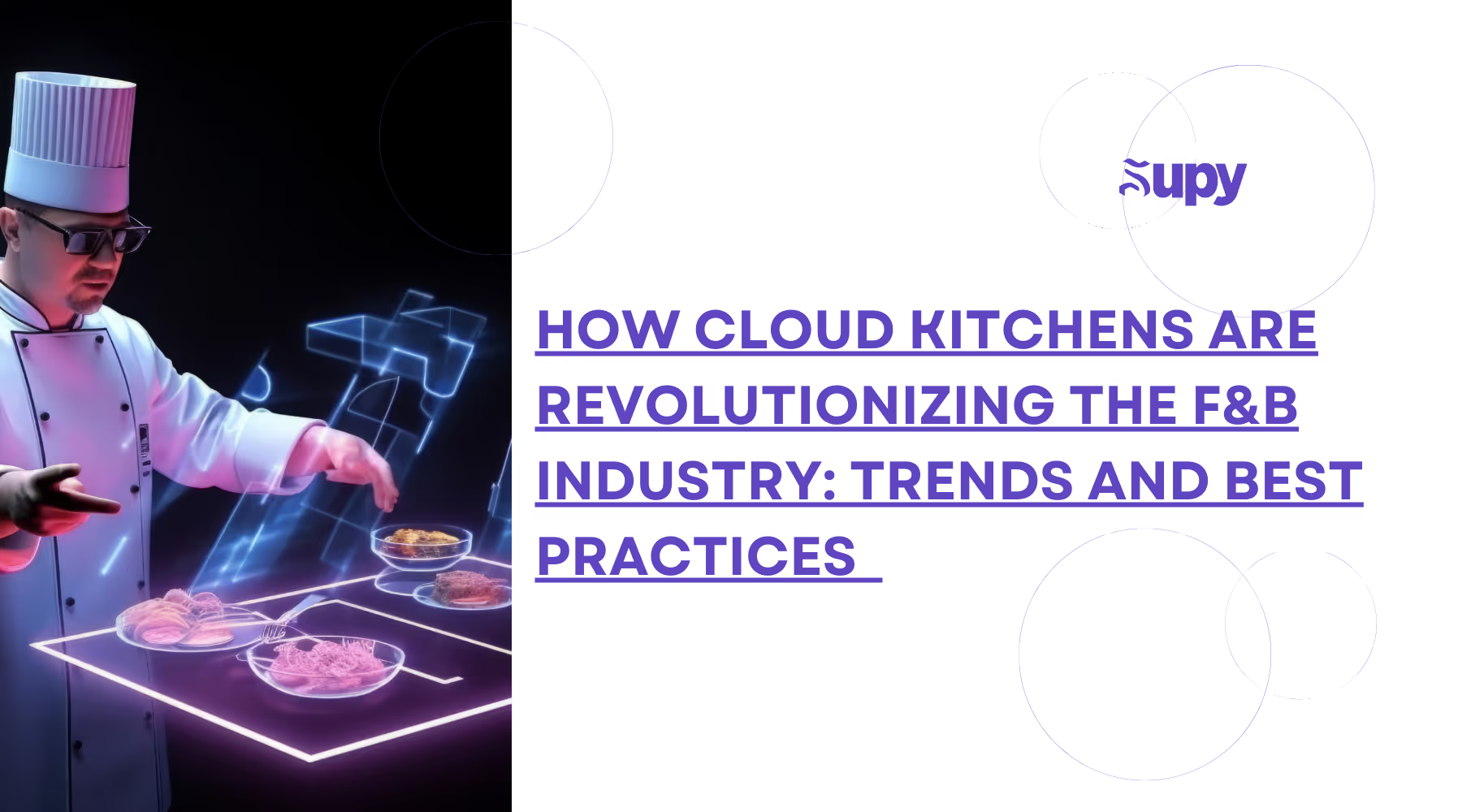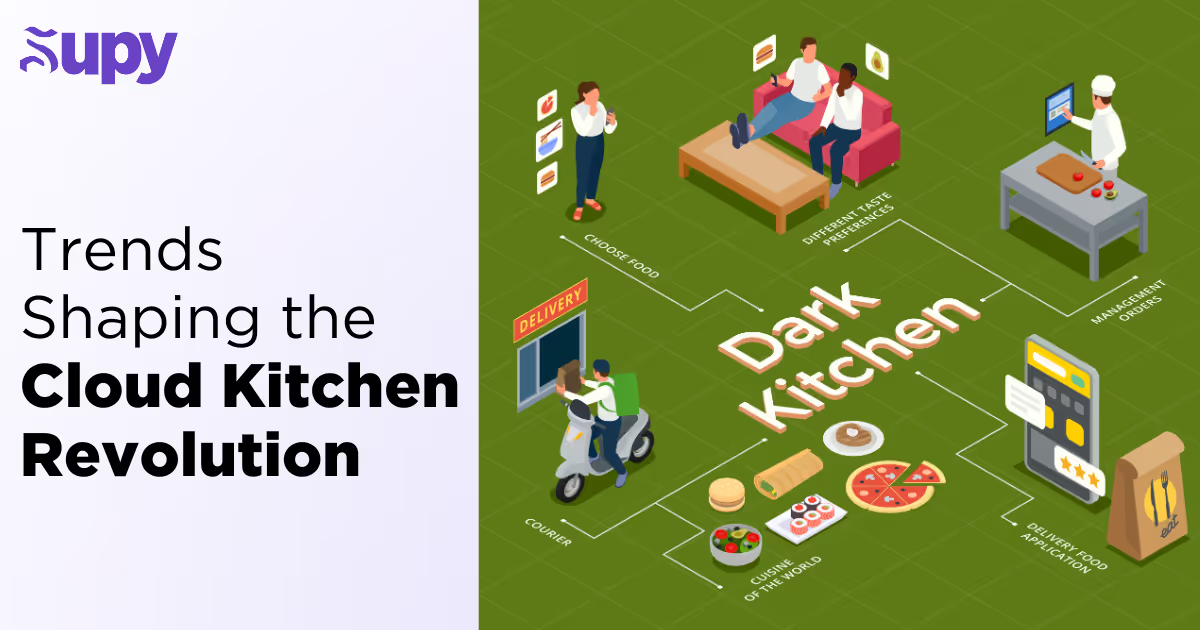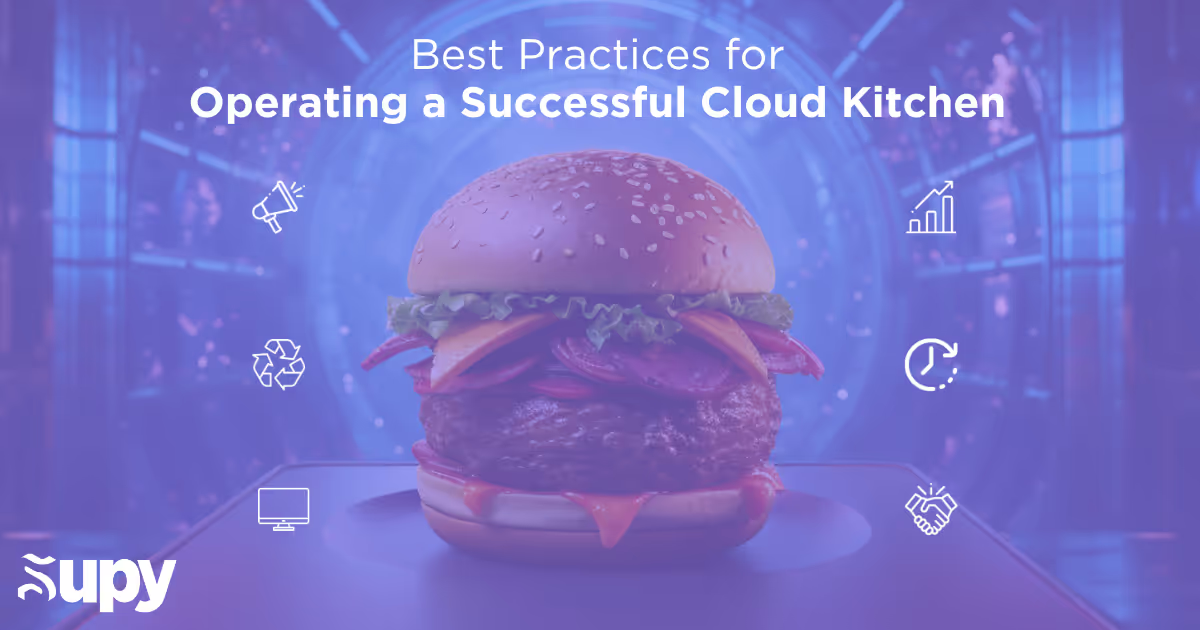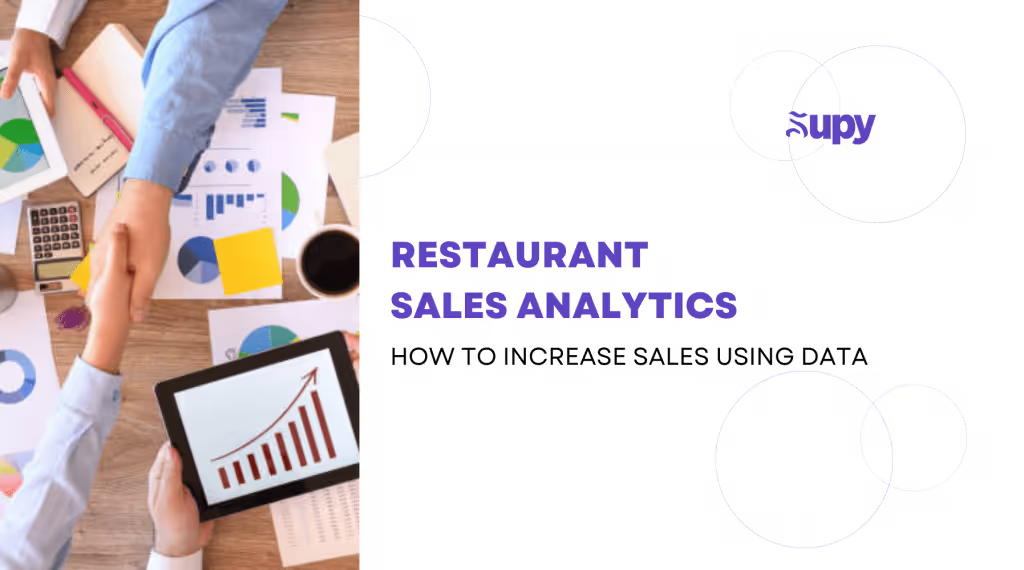How Cloud Kitchens Are Revolutionizing the F&B Industry: Trends and Best Practices

The global cloud kitchen market is on a rapid rise, projected to reach a staggering USD 117.89 billion by 2031 with a CAGR of 13.18%. This growth is fueled by the increasing shift towards online food ordering, making cloud kitchens a compelling alternative to traditional restaurants.
With the demand for quick, convenient, and diverse online food delivery options soaring, cloud kitchens have become essential players in the food and beverage industry. Notably, China and India lead the way, together holding over 50% of the market share, showcasing the immense potential of this sector.
In this article, we'll cover:
- What Are Cloud Kitchens?
- How Are Cloud Kitchens Different from Traditional Brick-and-Mortar Restaurants?
- Impact of Cloud Kitchens on the Food & Beverage Industry
- Trends Shaping the Cloud Kitchen Revolution
- Case Studies: Success Stories in the Cloud Kitchen Space
- Best Practices for Operating a Successful Cloud Kitchen
- Challenges and Opportunities for Cloud Kitchens
- Conclusion
- About Supy
By the end of this article, you’ll have a clear understanding of how cloud kitchens are revolutionizing the F&B industry and what it takes to succeed in this competitive market.
1. What Are Cloud Kitchens?
Cloud kitchens, also known as delivery-only kitchens, virtual restaurants, ghost kitchens, or dark kitchens, are facilities specifically designed to prepare food for the online food delivery market. Unlike traditional restaurants, they don’t have a dining area, so all orders are placed online, typically through food delivery apps. These kitchens can host multiple brands under one roof, each operating independently to serve a variety of cuisines.
The concept of cloud kitchens is straightforward yet transformative. Unlike traditional restaurants, which cater to both dine-in and delivery customers, cloud kitchens focus solely on preparing food for delivery. This model has gained popularity because it allows entrepreneurs and established brands to serve customers without the high costs associated with running a physical brick-and-mortar restaurant.
The ability to reach customers through delivery apps and digital platforms has made ghost kitchens an attractive option in today’s fast-paced world.
2. How Are Cloud Kitchens Different from Traditional Brick-and-Mortar Restaurants?

Cloud kitchens and traditional brick-and-mortar restaurants serve the same purpose—preparing and providing food—but they operate in fundamentally different ways.
1. Physical Location and Infrastructure
Traditional brick-and-mortar restaurants are designed to serve customers in a physical location, requiring a dedicated dining area, waitstaff, and often a prime, high-traffic location to attract diners. These restaurants invest heavily in ambiance, décor, and customer service to enhance the dining experience.
In contrast, cloud kitchens eliminate the need for these elements. They operate out of more cost-effective, often less visible locations, focusing solely on the kitchen where food is prepared. There’s no need for a dining area, which drastically reduces overhead costs.
2. Cost Structure and Flexibility
Brick-and-mortar restaurants typically have higher overhead costs due to rent, utilities, staffing, and the need for ongoing maintenance of the dining space. Additionally, they are often bound by their location, making it challenging to adapt quickly to changing market conditions or expand to new areas.
Cloud kitchens, on the other hand, benefit from significantly lower overhead costs. Without the need for a physical storefront, they can operate with a leaner business model. This allows for greater flexibility in menu offerings, the ability to quickly enter new markets, and the agility to adjust to changing consumer demands without the constraints of a traditional restaurant setup.
3. Customer Interaction
In traditional restaurants, the customer experience is heavily influenced by direct interaction with staff, the ambiance of the space, and the overall dining atmosphere. Customer loyalty is often built on these in-person experiences.
Cloud kitchens, however, interact with customers exclusively through digital platforms and delivery apps. The focus is entirely on the quality of the food and the efficiency of the delivery service, making online presence and digital marketing critical for success.
3. Impact of Cloud Kitchens on the Food & Beverage Industry
Cloud kitchens are disrupting traditional restaurant models by offering a more cost-effective way to operate. Without the need for prime real estate or a full front-of-house staff, cloud kitchens can focus on what they do best—cooking great food. This shift has led some traditional restaurants to either adopt cloud kitchen strategies or even convert entirely to this model to stay competitive.
As a result, the F&B industry is witnessing a transformation in how food is prepared, delivered, and consumed.
Operational Efficiency:
- Cloud kitchens eliminate costs associated with traditional restaurants (e.g., prime location rent, interior design, front-of-house staff).
- Focus on centralizing food production, utilizing technology for order management, and benefiting from economies of scale.
- Multiple brands or cuisines can be prepared in the same space, reducing costs further.
New Business Models:
- Emergence of virtual brands tailored to specific customer segments or trending cuisines.
- Cloud kitchens can operate many brands from a single location, maximizing space and resources.
- Flexibility and adaptability allow for quick pivots in response to market trends.
Consumer Behavior Changes:
- Increased demand for convenience and variety due to the rise of food delivery apps.
- Cloud kitchens cater to this demand with diverse menu options and quick delivery times.
- Ability to experiment with new dishes or cuisines, staying ahead of consumer trends.
Digital Transformation:
- Cloud kitchens are built on digital tools, from online ordering platforms to advanced analytics.
- Digital marketing and data-driven decision-making optimize operations and reduce waste.
- Leading the F&B industry’s digital transformation, leveraging new technologies for greater efficiency and profitability.
4. Trends Shaping the Cloud Kitchen Revolution

The rise of cloud kitchens is closely tied to shifts in consumer behavior and advances in technology. As online food ordering becomes an integral part of modern life, cloud kitchens are uniquely positioned to meet the growing demand for convenient, diverse, and fast meal options. Let’s explore the key trends driving this revolution.
The Shift Towards Online Food Ordering
Consumers today are increasingly choosing the convenience of having meals delivered straight to their doors over dining out or cooking at home. This shift is largely due to busy lifestyles that leave little time for traditional dining experiences.
Cloud kitchens cater directly to this demand by offering quick, easy, and varied meal options without the need for a physical dining space. This makes them a perfect fit for today’s on-the-go consumers.
The Impact of Restaurant Technology on Operational Efficiency and Scalability
At the core of the cloud kitchen business model is advanced technology. These kitchens leverage sophisticated software for order management, inventory tracking, and customer communication, streamlining operations and enhancing efficiency.
Moreover, technology plays a crucial role in optimizing delivery routes, reducing wait times, and ensuring that food arrives fresh and hot. Data analytics further empowers cloud kitchens to refine their menus and effectively target customers. This tech-driven approach not only boosts operational efficiency but also enables rapid scalability, allowing cloud kitchens to serve a broader customer base with ease.
The Synergy Between Cloud Kitchens and Food Delivery Apps
Food delivery apps like Uber Eats, DoorDash, and Grubhub have been essential in the growth of cloud kitchens. These platforms allow cloud kitchens to reach a vast audience without the need for a customer-facing infrastructure.
The partnership is mutually beneficial: cloud kitchens gain access to a large customer base, while delivery apps enhance their offerings with a wider variety of innovative food options. This symbiotic relationship is propelling both the food delivery and cloud kitchen markets forward, making it easier for consumers to discover and order from cloud kitchens.
Embracing Sustainability: Cloud Kitchens Meet Consumer Demands
As environmental consciousness among consumers grows, cloud kitchens are increasingly adopting sustainable practices. This includes using eco-friendly packaging, sourcing ingredients locally to reduce carbon footprints, and minimizing food waste through precise inventory management.
Additionally, some cloud kitchens are experimenting with plant-based menus and other innovations that cater to the demand for healthier, more sustainable food options. By embracing these sustainable practices, cloud kitchens not only appeal to eco-conscious consumers but also contribute to the broader movement towards a greener food and beverage industry.

5. Case Studies: Success Stories in the Cloud Kitchen Space
The cloud kitchen industry has seen remarkable success stories across the globe. Here are some notable examples of cloud kitchens that have significantly impacted the industry:
1. Rebel Foods (India)
Rebel Foods, based in India, is a global leader in the cloud kitchen industry. They operate multiple virtual kitchens under brands like Faasos, Behrouz Biryani, and Oven Story Pizza. By leveraging data analytics, Rebel Foods continuously refines its offerings, enabling them to expand internationally and set a high standard in operational excellence.
2. CloudKitchens (USA)
Founded by former Uber CEO Travis Kalanick, CloudKitchens provides fully equipped kitchen spaces and services to food entrepreneurs across major U.S. cities. Their focus is on helping businesses scale quickly with minimal cost and low risk, utilizing technology, real estate solutions, and data-driven operational optimization.
3. Taster (UK/Europe)
Taster is a European cloud kitchen startup that manages brands such as Out-Fry and A Burgers, focusing on globally inspired, high-quality food. They build strong brand identities and leverage technology to ensure consistent quality and efficient delivery across the UK, France, and Spain.
4. Kitopi (Middle East/Global)
Dubai-based Kitopi manages end-to-end cloud kitchen operations for restaurant operators and partners across the Middle East, U.S., and Europe. Kitopi's "managed cloud kitchen" model handles everything from sourcing ingredients to delivery, enabling restaurant owners and brands to expand without the need for physical locations.
6. Best Practices for Operating a Successful Cloud Kitchen

To excel in the competitive cloud kitchen industry, it’s essential to adopt strategies that enhance efficiency, customer satisfaction, and brand visibility. Here are six best practices that can help ensure success:
Data-Driven Decision Making
Leveraging data is crucial for optimizing operations in a cloud kitchen. By analyzing customer preferences, order patterns, and sales trends, ghost kitchens can tailor their menu offerings to better meet demand. This data-driven approach also helps in optimizing pricing and predicting ingredient needs, reducing waste, and ensuring smooth operations.
Leveraging Technology
Technology forms the backbone of cloud kitchen operations. Advanced order management systems and inventory tracking software streamline the entire process from order placement to delivery. Additionally, customer engagement tools like personalized marketing and feedback systems enhance the overall customer experience, making it easier to deliver food efficiently while minimizing errors.
Focus on Sustainability
Sustainability is increasingly important in the food industry, and ghost kitchens can lead the way by adopting eco-friendly practices. This includes using recyclable packaging, sourcing ingredients locally to minimize the carbon footprint, and implementing waste management practices like composting. These efforts not only attract eco-conscious consumers but also contribute to a greener industry.
Strategic Partnerships with Online Food Delivery Platforms
Forming strong partnerships with online food delivery platforms is essential for ghost kitchens. These platforms offer access to a large customer base and can significantly increase orders. Collaborative marketing efforts and data sharing with these platforms can further refine services, improve customer satisfaction, and foster loyalty.
Ensuring Operational Efficiency
Operational efficiency is key to the success of a ghost kitchen. This involves maintaining a streamlined menu, optimizing workflows, and ensuring that staff are cross-trained to handle multiple tasks. Just-in-time inventory management and strong supplier relationships help reduce costs and waste, enhancing overall efficiency and food safety.
Building a Strong Online Presence
An active online presence is vital for attracting and retaining customers. This includes having a user-friendly website, being active on social media, and leveraging food delivery demand through online platforms for increased visibility. A strong online presence helps ghost kitchens connect with customers and drive business growth.
7. Challenges and Opportunities for Cloud Kitchens
As cloud kitchens continue to grow in popularity, they face significant challenges but also have substantial opportunities for growth and expansion. Understanding both the hurdles and the potential can help cloud kitchens navigate the competitive landscape effectively and carve out their niche in the market.
Challenges Faced by Cloud Kitchens
- Competition: The cloud kitchen industry is becoming increasingly competitive, with new players regularly entering the market. This competition can make it difficult for individual cloud kitchens to stand out and attract customers.
Unlike existing restaurants that benefit from a physical presence, cloud kitchens must develop unique value propositions and effective marketing strategies to differentiate themselves. - Quality Control: Maintaining consistent food quality across multiple locations and high order volumes presents significant challenges. Ensuring that each dish meets the brand's standards requires robust systems for food preparation, as well as standardized kitchen equipment and processes.
Cloud kitchens need to focus on quality control to maintain customer trust, regardless of the commercial kitchen space they operate from. - Customer Retention: With a range of options available to consumers, retaining customers is another major challenge. Cloud kitchens must deliver a consistently excellent experience to build loyalty. This includes not only the quality of the food but also the efficiency of the delivery service and the overall customer experience.
Meeting these expectations is crucial in a market where consumers have countless choices.
Opportunities for Growth and Expansion
- Expansion into New Markets: One of the key advantages of cloud kitchens is their flexibility in expanding into new geographic markets with lower risk compared to traditional restaurants.
The ability to quickly set up operations in new commercial kitchen spaces allows cloud kitchens to reach a broader audience and capitalize on emerging markets, leading to significant growth opportunities. - Diversification of Offerings:
Cloud kitchens have the agility to test and introduce new cuisines or menu items quickly, catering to emerging trends or niche markets.
This flexibility enables them to diversify their offerings, tapping into new customer segments and responding swiftly to changing consumer preferences. Such adaptability can lead to both increased revenue and customer satisfaction. - Technological Innovations:
As technology continues to evolve, cloud kitchens have the opportunity to adopt new tools and platforms that can streamline operations, enhance the customer experience, and drive growth.
Innovations in order management, delivery logistics, and kitchen equipment contribute to cost savings and operational efficiency. Leveraging these technologies provides cloud kitchens with a competitive edge in the crowded market.
8. Conclusion
Cloud kitchens are reshaping the restaurant industry by offering a flexible, cost-effective, and technology-driven alternative to the traditional restaurant model. As these kitchens continue to adapt to consumer demands and technological advancements, they are well-positioned to overcome the challenges of a competitive market and capitalize on growth opportunities.
By focusing on quality, innovation, and operational efficiency, cloud kitchens are set to play an increasingly vital role in the future of dining, offering the ability to operate multiple restaurants under one roof without the constraints of physical locations.
9. About Supy
In the competitive world of cloud kitchens, efficiency and cost control are key. Supy is the all-in-one inventory management platform designed to streamline operations and boost profitability. With modules like Procurement, Inventory Management, and Reports & Analytics, Supy delivers the data-driven insights needed to optimize your food business.
Trusted by industry leaders such as Tashas, Pinza!, and over 2,000 other top virtual restaurant brands, Supy ensures your kitchen runs smoothly with user-friendly, accurate tools. Ready to elevate your cloud kitchen?






